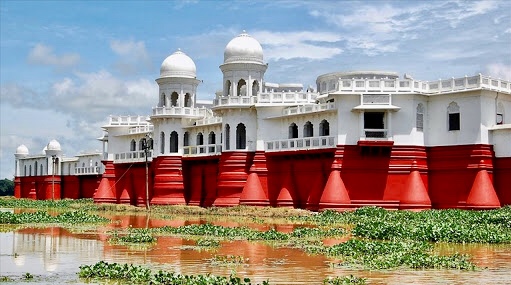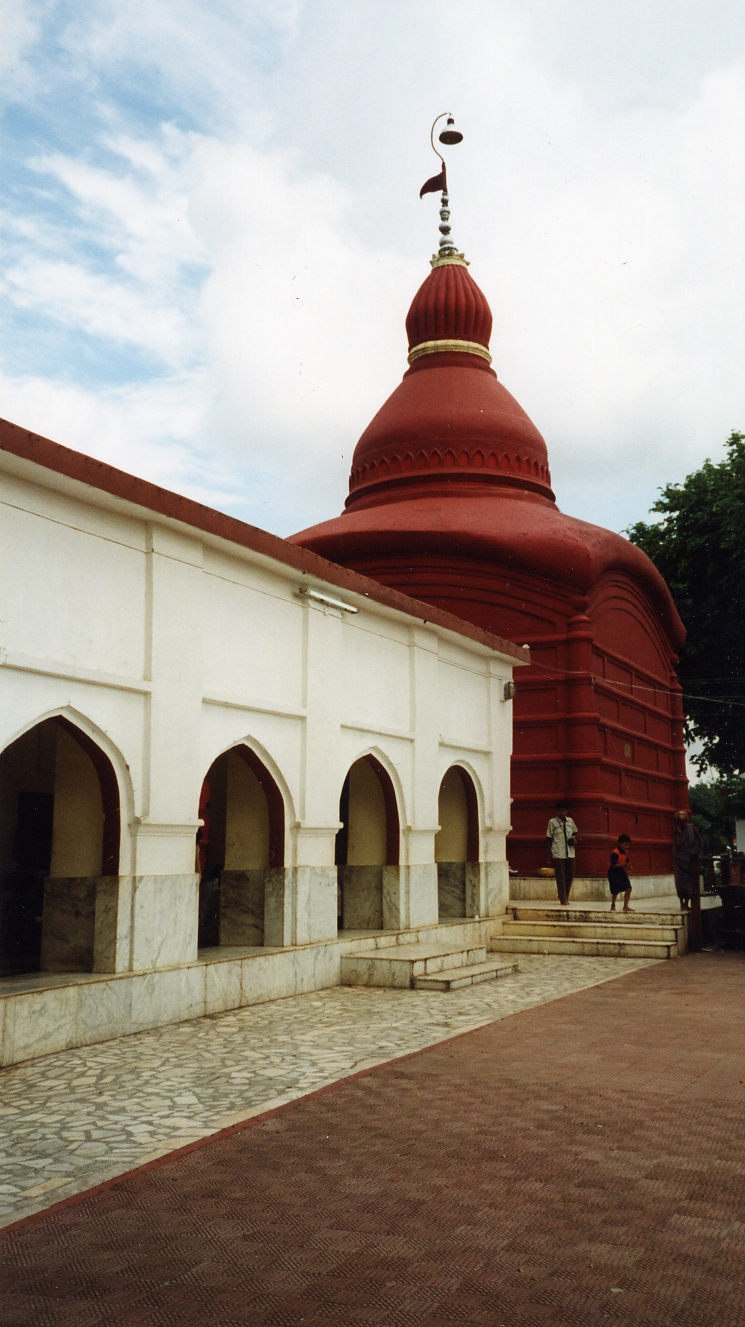|
Neermahal
Neermahal (''Twijilikma Nuyung''; lit. "Water Palace") is a former royal palace built by Maharaja of Tripura Kingdom '' Bir Bikram Kishore Manikya bahadur'' of the erstwhile Kingdom of Tripura, India in the middle of the lake Twijilikma (Now known as Rudrasagar) in the 1930s. It is situated in Melaghar, 53 kilometers away from Agartala, the capital of Tripura. The palace is situated in the middle of Rudrasagar Lake and assimilates Hindu architectural style. History The palace was built in the 1930s. Architecture The palace is the largest of its kind in India and the only one in Eastern India. It is so huge, it cannot be fit into a single picture frame on the standard camera until you are at a distance of approximately 800 metres from the entrance. There are only two water palaces in India, the other one being the Jal Mahal in Rajasthan. However, the latter is significantly smaller in size than Neermahal. Known as the ‘lake palace’ of Tripura, Neer-Mahal was cons ... [...More Info...] [...Related Items...] OR: [Wikipedia] [Google] [Baidu] |
Melaghar
Melaghar is a small town located in the Indian state of Tripura and a Municipal Council in Sipahijala district, situated about 50 km (approx. 30 miles) from the capital Agartala. It is a neighbour to Sonamura and 10 km (6 miles) away from the Bangladesh International border. Neermahal is a famous tourist attraction in the town, situated in the middle of Rudrasagar Lake. Geography and climate Melaghar is situated in a low elevation of . Melaghar has a tranquil climate most of the year. However, summertime can be excessively hot, dry, humid, and interspersed with rains and thunderstorms. Winter generally starts towards the end of November and lasts until February, where the temperatures can reach very low conditions. The monsoon season starts in April, during the Bengali month of Boishakh. During the monsoon season, Melaghar is inundated frequently due to excessive rainfall and flooding by the local rivers, most memorably by the 1993 and 2007 Tripura Floods. Demograp ... [...More Info...] [...Related Items...] OR: [Wikipedia] [Google] [Baidu] |
Tripura
Tripura (, Bengali: ) is a state in Northeast India. The third-smallest state in the country, it covers ; and the seventh-least populous state with a population of 36.71 lakh ( 3.67 million). It is bordered by Assam and Mizoram to the east and by Bangladesh to the north, south and west. Tripura is divided into 8 districts and 23 sub-divisions, where Agartala is the capital and the largest city in the state. Tripura has 19 different tribal communities with a majority of the Bengali population. Bengali, English and Kokborok are the state's official languages. The area of modern Tripura — ruled for several centuries by the Manikya Dynasty — was part of the Tripuri Kingdom (also known as Hill Tippera). It became a princely state under the British Raj during its tenure, and acceded to independent India in 1947. It merged with India in 1949 and was designated as a 'Part C State' ( union territory). It became a full-fledged state of India in 1972. Tripura lies in a g ... [...More Info...] [...Related Items...] OR: [Wikipedia] [Google] [Baidu] |
Rudrasagar Lake
Rudrasagar Lake, also known as Twijilikma, is a lake located in Melaghar, Tripura, India. The Government of India's Ministry of Environment, Forest and Climate Change has identified Rudrasagar as one of the wetlands of National Importance for conservation and sustainable use based on its bio-diversity and socio economic importance. The secretary general of the Ramsar Convention has declared Rudrasagar Lake as a wetland of international importance. This certificate has been communicated by Ministry of Environment and Forests, Govt. of India on 29 February 2007. Geography The Rudrasagar Lake is located in the Melaghar block of Sonamura sub-division of Sipahijala district. The lake forms a geographical area of 2.4 km2 and situated at a distance of about 52 km from the state capital of Tripura. The lake is situated in between 23°29’ N and 90°01’ E. Hydromorphologically, Rudrasagar Lake is a natural sedimentation reservoir, which receives flow from three perennial st ... [...More Info...] [...Related Items...] OR: [Wikipedia] [Google] [Baidu] |
Tripura (princely State)
Tripura State, also known as Hill Tipperah, was a princely state in India during the period of the British Raj and for some two years after the departure of the British. Its rulers belonged to the Manikya dynasty and until August 1947 the state was in a subsidiary alliance, from which it was released by the Indian Independence Act 1947. The state acceded to the newly independent Indian Union on 13 August 1947, and subsequently merged into the Indian Union in October 1949. The princely state was located in the present-day Indian state of Tripura. The state included one town, Agartala, as well as a total of 1,463 villages. It had an area of 10,660 km2 and a population of 513,000 inhabitants in 1941. History The predecessor state of Tripura was founded about 100 AD. According to legend the Manikya dynasty derived its name from a jewel ('Mani' in Sanskrit) that had been obtained from a frog. The first king who ruled the state under the royal title of Maniky ... [...More Info...] [...Related Items...] OR: [Wikipedia] [Google] [Baidu] |
Hindu
Hindus (; ) are people who religiously adhere to Hinduism.Jeffery D. Long (2007), A Vision for Hinduism, IB Tauris, , pages 35–37 Historically, the term has also been used as a geographical, cultural, and later religious identifier for people living in the Indian subcontinent. The term ''"Hindu"'' traces back to Old Persian which derived these names from the Sanskrit name ''Sindhu'' (सिन्धु ), referring to the river Indus. The Greek cognates of the same terms are "''Indus''" (for the river) and "''India''" (for the land of the river). The term "''Hindu''" also implied a geographic, ethnic or cultural identifier for people living in the Indian subcontinent around or beyond the Indus River, Sindhu (Indus) River. By the 16th century CE, the term began to refer to residents of the subcontinent who were not Turkic peoples, Turkic or Muslims. Hindoo is an archaic spelling variant, whose use today is considered derogatory. The historical development of Hindu self-i ... [...More Info...] [...Related Items...] OR: [Wikipedia] [Google] [Baidu] |
Manikya Dynasty
The Manikya dynasty was the ruling house of the Twipra Kingdom and later the princely Tripura State, what is now the Indian state of Tripura. Ruling since the early 15th century, the dynasty at its height controlled a large swathe of the north-east of the Indian subcontinent. After coming under British influence, in 1761 they transitioned from feudal monarchs into rulers of a princely state, though the Manikyas maintain control of the region until 1949, when it ascended in union with India. History Tracing a descent from the mythological Lunar dynasty, the ''Rajmala'' royal chronicle records an unbroken line of 144 (likely legendary) monarchs of Tripura up to the ascension of one Ratna Fa, who is stated to have become the first Manikya after being granted the cognomen by the Sultan of Bengal. However, it is now believed that the ''Rajmala'' had been mistaken in the genealogy and chronology of the initial Manikya rulers. Numismatic evidence suggests that the first historical M ... [...More Info...] [...Related Items...] OR: [Wikipedia] [Google] [Baidu] |
Martin And Burns
Martin may refer to: Places * Martin City (other) * Martin County (other) * Martin Township (other) Antarctica * Martin Peninsula, Marie Byrd Land * Port Martin, Adelie Land * Point Martin, South Orkney Islands Australia * Martin, Western Australia * Martin Place, Sydney Caribbean * Martin, Saint-Jean-du-Sud, Haiti, a village in the Sud Department of Haiti Europe * Martin, Croatia, a village in Slavonia, Croatia * Martin, Slovakia, a city * Martín del Río, Aragón, Spain * Martin (Val Poschiavo), Switzerland England * Martin, Hampshire * Martin, Kent * Martin, East Lindsey, Lincolnshire, hamlet and former parish in East Lindsey district * Martin, North Kesteven, village and parish in Lincolnshire in North Kesteven district * Martin Hussingtree, Worcestershire * Martin Mere, a lake in Lancashire ** WWT Martin Mere, a wetland nature reserve that includes the lake and surrounding areas * Martin Mill, Kent North America Canada * Rural Municipality ... [...More Info...] [...Related Items...] OR: [Wikipedia] [Google] [Baidu] |
Rajasthan
Rajasthan (; lit. 'Land of Kings') is a state in northern India. It covers or 10.4 per cent of India's total geographical area. It is the largest Indian state by area and the seventh largest by population. It is on India's northwestern side, where it comprises most of the wide and inhospitable Thar Desert (also known as the Great Indian Desert) and shares a border with the Pakistani provinces of Punjab to the northwest and Sindh to the west, along the Sutlej- Indus River valley. It is bordered by five other Indian states: Punjab to the north; Haryana and Uttar Pradesh to the northeast; Madhya Pradesh to the southeast; and Gujarat to the southwest. Its geographical location is 23.3 to 30.12 North latitude and 69.30 to 78.17 East longitude, with the Tropic of Cancer passing through its southernmost tip. Its major features include the ruins of the Indus Valley civilisation at Kalibangan and Balathal, the Dilwara Temples, a Jain pilgrimage site at Rajasthan's only hi ... [...More Info...] [...Related Items...] OR: [Wikipedia] [Google] [Baidu] |
Jal Mahal
Jal Mahal (meaning "Water Palace") is a palace in the middle of the Man Sagar Lake in Jaipur city, the capital of the state of Rajasthan, India. The palace was originally constructed in 1699; the building and the lake around it were later renovated and enlarged in the 18th century by Maharaja Jai Singh II of Amber. The Palace The Jal Mahal palace is an architectural showcase of the Rajput style of architecture (common in Rajasthan) on a grand scale. The building has a picturesque view of Man Sagar Lake, but owing to its seclusion from land is equally the focus of a viewpoint from the Man Sagar Dam on the eastern side of the lake in front of the backdrop of the surrounding Nahargarh ("tiger-abode") hills. The palace, built in red sandstone, is a five-storied building, of which four floors remain underwater when the lake is full and the top floor is exposed. One rectangular Chhatri on the roof is of the Bengal type. The chhatris on the four corners are octagonal. The palace h ... [...More Info...] [...Related Items...] OR: [Wikipedia] [Google] [Baidu] |
Agartala
Agartala () is the capital city of the Indian state of Tripura, and is one of the largest cities in northeast India. The city is governed by the Agartala Municipal Corporation. The city is the seat of the Government of Tripura. It is located on the banks of the Haora River, near the Bangladesh–India border, Bangladesh border, about east of Bangladesh's capital Dhaka and about 2,499 km (1,522 mi) from the national capital New Delhi. Agartala is being developed under the Smart Cities Mission, a flagship scheme of the Government of India. Agartala is India's third international internet gateway after the ones in Mumbai and Chennai. Etymology Agartala is a derivative of two words, namely ''Agarwood, agar'', a valuable perfume and incense tree of genus Aquilaria, and the suffix ''tala'', meaning ''underneath,'' a reference to the density of agarwood trees in the region. The agar tree is historically referred to in the story of the King Raghu who tied up his elephant's ... [...More Info...] [...Related Items...] OR: [Wikipedia] [Google] [Baidu] |




.jpg)


